Via dolorosa
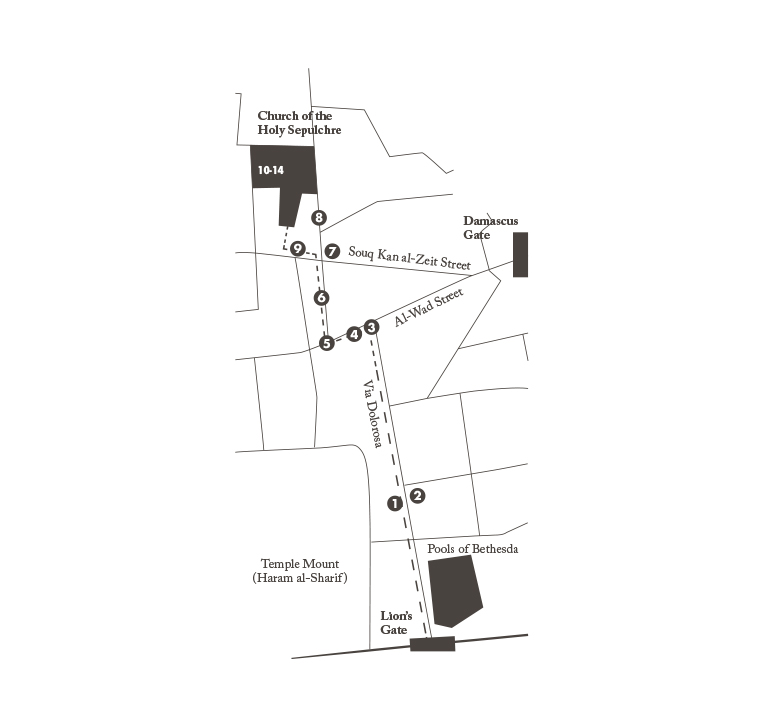
PRVA ZASTAVKA
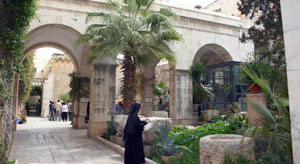
Ecce Homo Arch
The central opening of the arch of Ecce Homo (Latin for "behold the man"), seen here, is part of an Early Roman arch which had triple openings. According to tradition, this is the site Pilate presented Jesus to the enraged jewish crowds. However, scholars are now fairly certain that Pilate carried out his judgements at Herod's Palace at the southwest side of the city, rather than at this point in the city's northeast corner.
This station begins in the courtyard of the Omariya Moslem College on the street called the Via Dolorosa. This is the traditional location of the Praetorium of Pilate and the Lithostrotos, the place where Jesus was scourged, condemned and where he received his crown of thorns.
Kde je Herodesov Palac
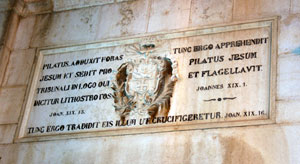
This station is made along the road between the Omariya Moslem College and the Franciscan museum and library.
The 2nd
OBLUK ECCE HOMO - na pamiatku slov Pilata po bicovani Jezisa
Frantiskansky kostol
Vstupime a vlavo - tu podla tradicie Jezis prijal svoj KRIZ
Je tu kaplnka bicovania vpravo - na mietse, kde bol podla tradicie Pan jezis bicovany.
DRUHA - Pilatov sud
The 2nd station of the Via Dolorosa is located in the arch of Ecce Homo, in memory of the words of Pontius Pilate after the scourging of Jesus. This arch was built by Hadrian in 135, after putting down the last Hasmonean revolt under the command of Bar Kokhva.
Second Station marker at Franciscan Monastery and the Church of the Condemnation and Imposition of the Cross. According to tradition it where the Cross was imposed on Jesus, and he was condemned by the crowd. There is a large area of Roman paving, beneath these structures, was traditionally regarded as the Roman pavement (Greek: lithostratos) described by the Bible as the location of Pilate's judgment of Jesus
Tretia
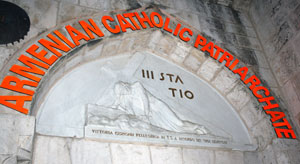
This station is located a short walk from the Ecce Homo ("Behold the Man") Church at the corner of the Via Dolorosa and El Wad Street. Though not mentioned in the Gospels, it is believed Jesus fell near the ancient Fish Gate.
Third Station marker where Jesus falls for the first time under the weight of the cross that he is carrying. It is located around the Polish Catholic Church (built by the Armenian Catholics from Poland) on the corner of via Dolorosa and El Wad (Hagai) street. The tradition of the three falls appears to be a faded memory of an earlier belief in The Seven Falls; these were not necessarily literal falls, but rather depictions of Jesus coincidentally being prostrate, or nearly so.
Polsky kostol
On Al Wad St, just a few steps south of the Via Dolorosa, is the 3rd Station, where it is believed Jesus fell for the first time. The station is in the small chapel to the right of the entrance to the Armenian Catholic Patriarchate Hospice; you can walk down to the crypt.
In this location there is a Polish Catholic church which was actually purchased by Armenian Catholics basedin Poland. The relief at the entrance depicts Jesus falling for the first time under the weight of the cross as he walked along the Via Dolorosa. The church compound stretches along the street
until the Fourth Station of the Cross.
Stvrta
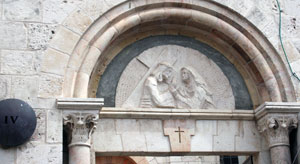
An image of Jesus meeting his mother with the cross appears on the doorway of a small chapel to mark this station. This event is also not mentioned in the Bible.
The present chapel was built in 1947 through donations made by Polish soldiers. We can enter the underground chambers to the right, where we will see the remains of the former Hamam al-Sultan Turkish bath; we can access the Fourth Station of the Cross from the Turkish bath. The events believed to have taken place at the Third and Fourth Stations come from traditions that postdate the New Testament.
Piata
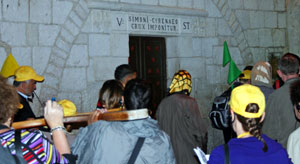
A small chapel was built in 1895 and dedicated to Simon of Cyrene to mark the fifth station. Earlier on this spot was the first home for the Franciscans when they came to Jerusalem in 1229.
The Via Dolorosa in Jerusalem | DOLR.org
Stations of Via Dolorosa - Madain Project (en)
----------------------------------

